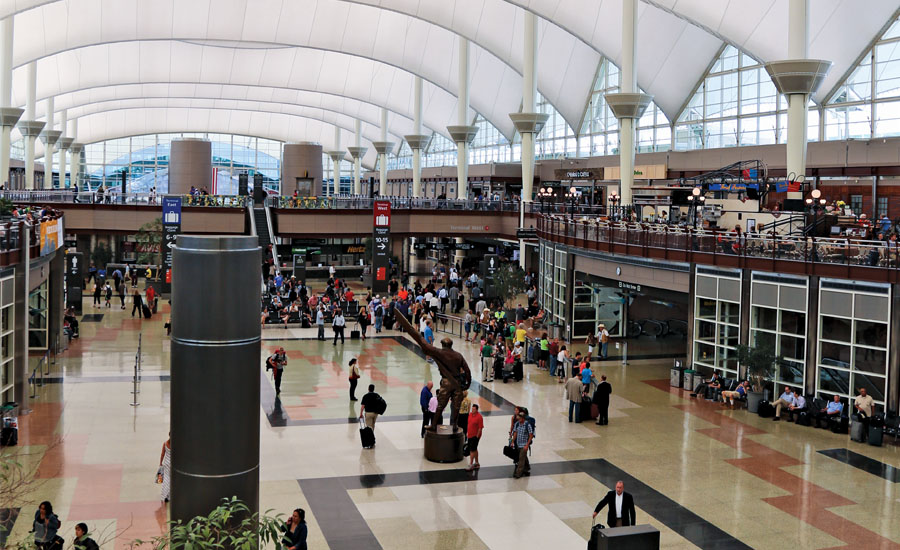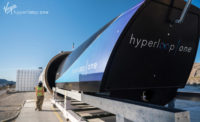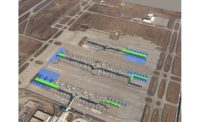The renovation of the Great Hall of Denver International Airport’s iconic Jeppesen Terminal, roofed by a series of peaked tensile tents that echo the nearby mountains, has hit a bump. Routine but limited concrete testing of the nearly quarter-century-old terminal’s elevated floor slab, to determine whether the floor could support crane loads, shows the compressive strength of the concrete in certain sections is lower than was specified for the original project, more than 25 years ago.
Though other work continues, steel erection is delayed to allow for additional tests and the time needed to better understand the existing conditions. “Experts in the field of structural engineering have informed us that the airport is safe and can support the construction,” says Stacey Stegman, senior vice president for marketing and communications for the airport, known as DEN. It isn’t uncommon for existing conditions not to match the as-builts, she says.
In April, DEN expects to have additional test results analyzed by its experts. At that time, there may be adjustments made to the schedule or to the means and methods. For example, “do we need to use a different type of crane?” asks Stegman.
In addition to compressive strength tests, a test was conducted that showed aggregate in the sample has properties that, under certain environmental circumstances, could lead to an alkali silica reaction. However, the current samples show no indication of an ASR issue, Stegman says.
Live Load
The airport, owned by the city and county of Denver, opened in 1995. The 1.5-million-sq-ft terminal has six levels beneath its 249,000-sq-ft fabric roof. The fabric tents were selected, among other reasons, because they can span 150 ft across the hall, according to the architect, C.W. Fentress J.H. Bradburn and Associates PC (ENR 9/7/92 p. 28), now Fentress Architects. The floor was designed for a live load of 250 psf to accommodate erection equipment for the 126-ft-tall steel roof masts that bear on the main floor.
The typical required live loading for an airport terminal occupancy is 100 psf, says Stegman.
The hall’s 3.5-year phased renovation, mostly to improve levels five and six, started last July. The project, which is ongoing in an active airport, is a public-private partnership with Denver Great Hall LLC, consisting of Ferrovial Airports, JLC Infrastructure and Saunders Concessions. Other equity partners include Magic Johnson Enterprises & Loop Capital; design-build partners Ferrovial Agroman and Saunders Construction; architectural firms Luis Vidal + Architects, Harrison Kornberg Architects and Anderson Mason Dale; legal adviser Gibson, Dunn & Crutcher; and financial adviser Citibank.
Denver's First P3
The project is Denver’s first airport P3. The 34-year agreement, which went into effect last year, calls for Denver Great Hall (DGH) to design and construct all the current improvements in four phases ending by late 2021 and operate and maintain specified commercial areas of the terminal for 30 years. The P3 contract amount is capped at $1.8 billion.
DGH, in its monthly report to the airport, said the concrete problem would cause a 209-day delay, which translates to about nine or 10 months. The Denver Post included a link to the Great Hall Project: December Construction Project Report in a Feb. 18 article. The report, released Feb. 14 to the airport, was first covered by Denver's CBS4.
DGH “is required to file a monthly construction report based on what they know at that particular point in time,” says Stegman. “The projected schedule represents their estimates but does not include the airport’s review and analysis or ways to mitigate.
“The issue cannot be fully known or realized until April,” she adds. “Then we’ll be able to determine any potential impacts to schedule or budget.”
DGH declined to comment. Its CEO, Ignacio Castejon, issued the following statement: “As part of the normal course of construction, Denver Great Hall LLC tested concrete samples from an area in the terminal. The preliminary testing showed the compressive strength of the existing concrete in some areas is lower than originally specified in the airport's historic documents."
The statement continued: "Additional test results are due in the coming months. We will review and analyze these results with DEN and determine next steps as well as any adjustments that might need to be made. Our recent construction update report projects an estimated and preliminary delay based on the current status of the project and the information we have as of today.”
Concrete Samples
The concrete samples were taken from the Phase I - MOD 2 area. About half of the cores, some of which showed the lower compressive strengths, were taken before year end. Additional testing includes the identification of core locations, testing of cores, petrographic analysis and engineering evaluation to determine the concrete strength and composition of slab areas within the project.
The airport also provided DGH with a report, dated Jan. 14, from another materials testing agency. The report confirmed the findings of the DGH tests and also indicated the aggregate samples had properties that could lead to ASR. A Jan. 28 addendum to the report added: "The presence of fly ash is detected in both samples. It is well established that the use of fly ash is very effective to control ASR if the fly ash content and quality is adequate."
The owner's report from its testing firm, Olson Engineering, concludes that because the concrete is 25 years old and there have been no ASR features observed in two samples, "it looks like the use of fly ash was adequate to make the concrete ASR resistant ...."
Upgrade
The upgrade will consolidate airline ticket counters; relocate TSA screening areas to the airport’s top level; modify the baggage-handling system under the terminal to support the relocated ticket counters; and redesign shopping and dining areas.
Last year, DEN put the anticipated cost of the project at $650 million to $770 million. The amount includes an airport-controlled contingency of $120 million. GHP made an initial investment of $258 million that will be repaid over time by the airport and a 20% share of the concession revenues from the 50 or so new shops and restaurants. DEN will also reimburse GHP for operating and maintenance costs over the 30-year term of the O&M agreement. The airport is paying for the remainder of the construction and will retain 80% of all concession revenue and 100% of other revenues from terminal spaces it operates.
DEN expects the project to create 400 to 450 construction jobs, more than 800 permanent jobs and generate an additional $3.5 million in annual taxes and general fund revenue for Denver.






Post a comment to this article
Report Abusive Comment